Massey Ferguson Red Giant tractor and implement collection
Posted by Chris Graham on 26th March 2024
Bob Weir meets Edward Green to discover more about his growing Massey Ferguson Red Giant tractor and implement collection.

Massey Ferguson Red Giant collection: Edward Green’s fine line-up of Massey Ferguson classics has been collected over the past 20 years. These Red Giant models were very popular with farmers and dominated the market during the late 1960s and early 1970s.
The River Severn is a major waterway and the longest river in the UK. It flows through the town of Bridgnorth, which, of course, has strong connections with the early days of the Industrial Revolution. But the river is also prone to flooding, and an alert had been issued at the time of my visit to the area, following a spell of heavy rain. Fortunately, Edward Green’s farm wasn’t affected, and he was able to bring his Red Giant tractor collection out into the autumn sunshine.
“My father started the farm, and I’ve lived here all my life,” Edward explained. “I’m semi-retired now, and most of the land is contracted out. Back in the old days we used to milk 120 cows, but the herd was sold in 1989. We were also lambing 1,000 ewes, so life was pretty hectic.”
Nowadays, though, the farm is given over to a mix of beef cattle and cereal crops. “We’ve also kept a suckler herd over the years,” he added. “They take some looking after. There’s also about 400 acres given over to barley, oats, wheat and rape seed.”
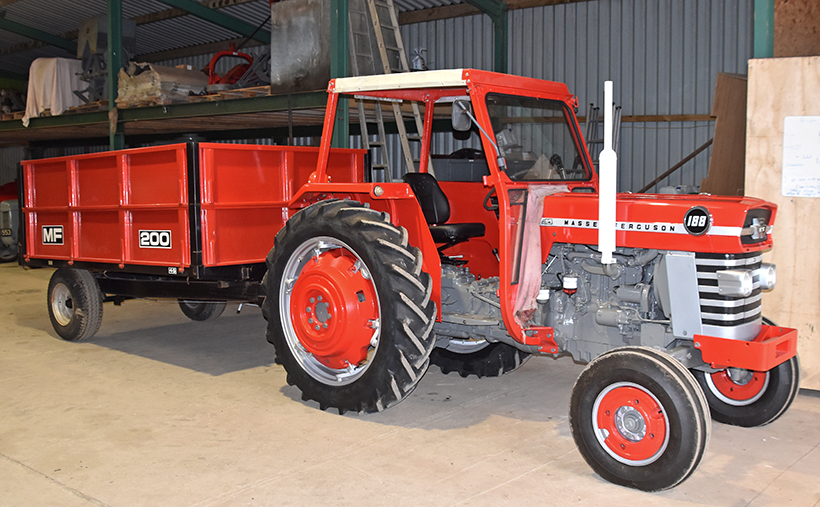
A very pleasing combination; Edward’s MF 188 and his MF 200 trailer, complete with fully re-lined interior.
Edward has been a Massey man for as long as he can remember, and the farm still uses Massey Ferguson tractors today. He also likes old MF and Ferguson implements, and is putting together a small collection.
Early interest
“I suppose my interest can be traced back to when I was photographed on a Ferguson TE-20, aged just 18 months,” he laughed. “The first Massey I actually drove was an MF 65. The farm also used MF 135s and 165s, and I remember we had an MF 188 working when I was a teenager. I thought they were great tractors, and I’ve recently added one to my collection.”
Edward also recalls his father was wary of buying Masseys fitted with Multi-Power. “He realised Multi-Power was an excellent option but was wary because a lot of our farm is on sloping ground. If Multi-Power did have a drawback, it was issues with engine braking.”
Massey Ferguson’s 100 Series ‘Red Giants’ set the standard in the 1960s. The range was very important for the company’s future as it faced stiff competition from the likes of Ford, Nuffield and David Brown.
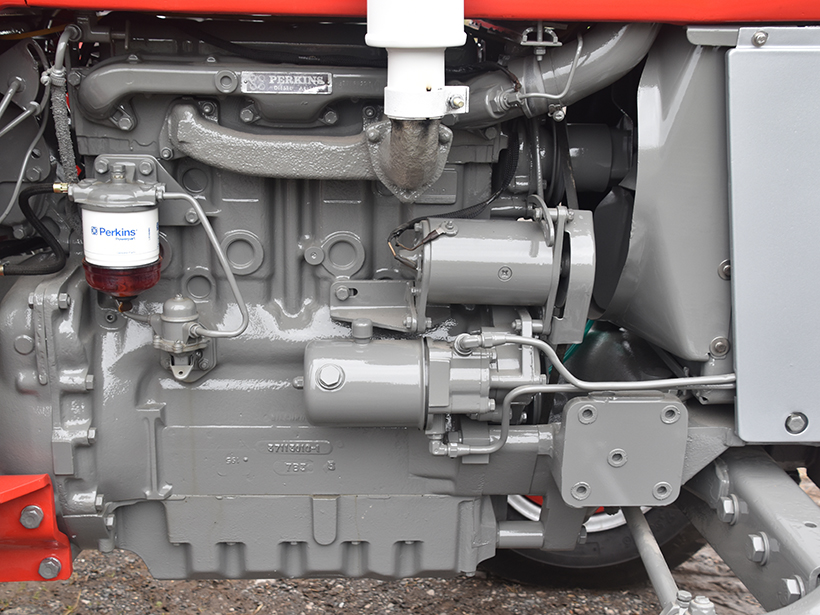
The MF 188 is powered by the Perkins A4.248; a durable, 4.1-litre, 75hp engine delivering a rated speed of 2,070rpm and 220.5lb/ft of torque.
Massey Ferguson had set up a Corporate Co-ordinating Committee in 1962, to follow-up the success of the best-selling MF 35 and MF 65. The result was the DX-line (100 and 1000). The new line-up targeted the development of new machines, and not the upgrading of old models. The tractors were aimed at the high-horsepower range, and the company was looking to achieve economies of scale. Part of this strategy involved building the machines at the most economical locations, as the new models were intended to be global tractors, suitable for the different Massey Ferguson markets.
New arrivals
Four new models were launched at the 1964 Smithfield Show in London. These were the MF 130, the MF 135, the MF 165 and the MF 175. The entry-level 130 was built in France, while the other three models were produced at Banner Lane, in Coventry. Massey Ferguson had opted for overall simplicity, and so was keen to avoid complex, hydrostatic transmissions. This meant that all the Coventry-built tractors were fitted with a basic, six-forward-and-two-reverse-speed gearbox.
The most significant change for the new tractors was the arrival of a new hydraulic system for the larger models. Massey Ferguson introduced a Pressure Control System that was designed to give additional traction using weight transfer. This involved a special linkage hitch attached to a chain, which was fixed to the implement’s drawbar.
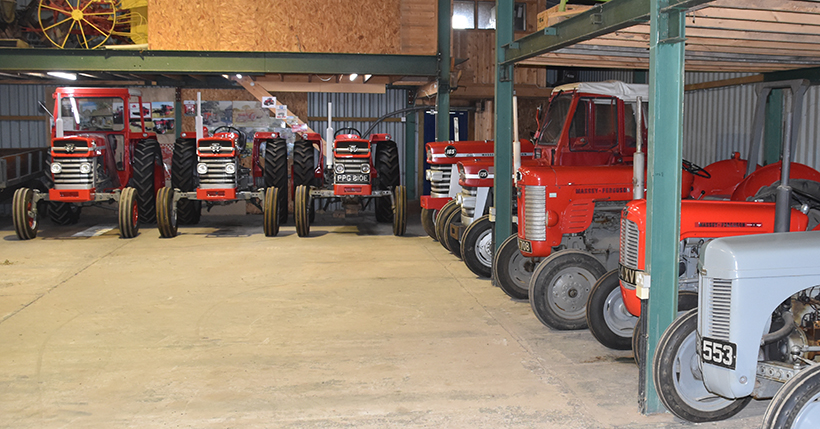
Edward is firmly of the opinion that good, covered storage is essential for any tractor collection. His machines are all kept well away from the elements. His grey Fergie is a TE-F 20 model.
Edward started collecting Massey tractors on his own account back in 2003. “The first tractor I acquired was an MF 65,” he recalls. “I’d always wanted a 65, as it reminded me of my younger days. I suppose the same applied to the MF 188.”
Edward’s MF 65 is a Mk.2. This upgrade was introduced in 1960, and featured the direct-injection Perkins AD4.203 engine that produced an additional 8hp compared to its predecessor. In addition, a diff lock was standard and Multi-Power was soon added to the list of optional extras.
“The MF 65 was a big tractor in its day, and a lot of them were used by contractors,” Edward added. “The tractor was well spec’d with the Ferguson system, dual-clutch, disc brakes and dual category linkage. My 65 isn’t fitted with power steering, but is still fun to drive. All-in-all, I think it’s a great machine!”
Finding tractors
Like many collectors, Edward finds his tractors from a number of sources, and uses the internet a lot. “The 65 came from Spalding, in Lincolnshire,” he told me. “I’d spotted an MF 168 being advertised in one of the Brown & Co auctions, and decided to send off for a catalogue. I thought it hadn’t been sold, so decided to chase it up. When I got to Lincoln, I spotted the MF 65 and ended up buying that one instead. I then arranged to have it delivered to me by a local haulage company.”
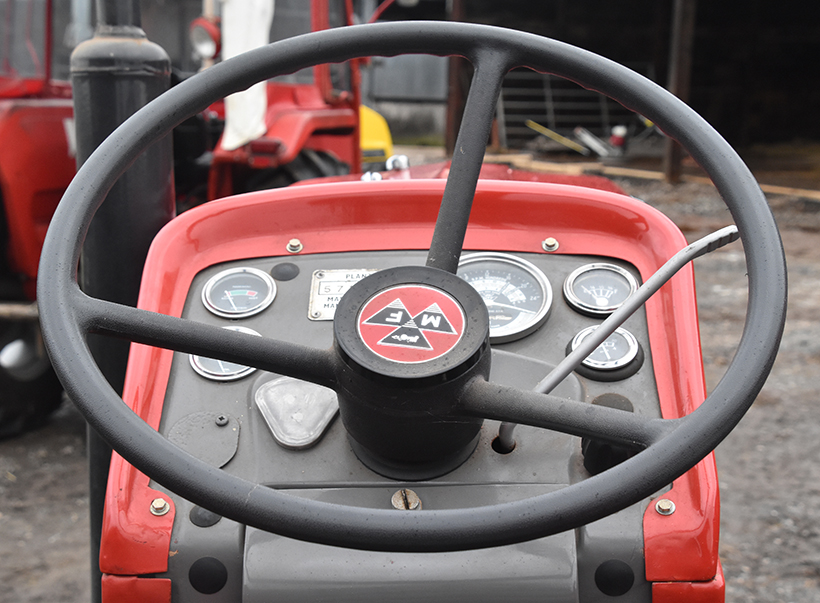
All Red Giants had similar controls, so they were capable of being driven by just the one operator.
Edward can still recall the feeling of excitement when the Massey arrived on his doorstep. “I remember the driver telling me that he had stopped off for a coffee break, and somebody had approached him offering a pile of cash for the tractor,” he laughed. “Fortunately, the driver wasn’t tempted, and I was still the new owner.”
Edward accumulated the rest of his collection over time, and from different sources. His most recent acquisition is the MF 188. “I spotted this one at the Tractor World Show at Malvern a couple of years ago,” he said. “I already knew the owner, as he’d been pestering me to buy the Massey for some time. I eventually agreed and we came to an arrangement.”
Although the tractor was in reasonable condition, Edward decided to give it a makeover. “I used Dave Lloyd at Dinmore Sandblasting Services, in Herefordshire,” he explained, “and he did an excellent job. The tractor has been around the houses a bit, but I think it was originally registered in Swindon.”
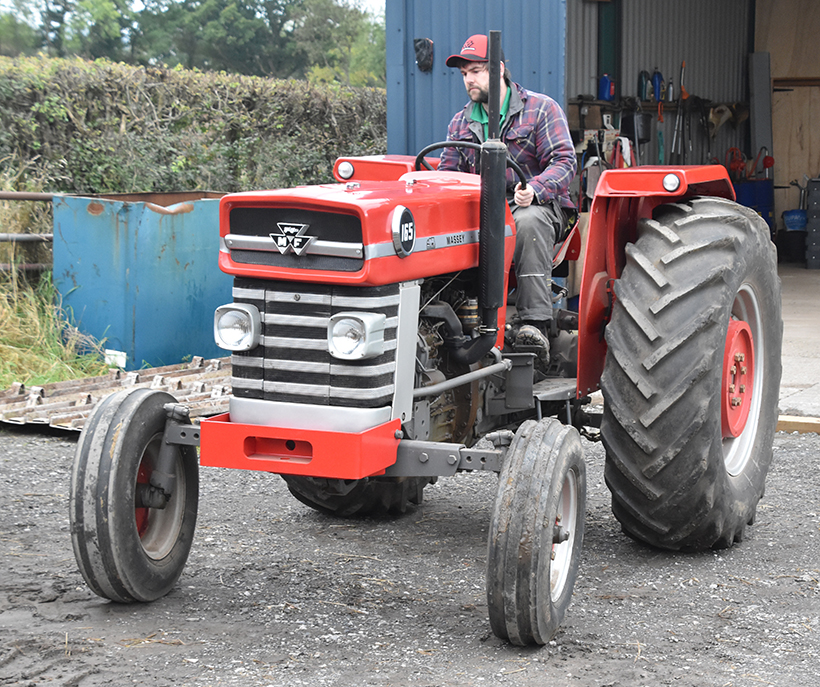
Edward’s son-in-law, Andrew, behind the wheel of the MF 165. It was the seventh of its type to come off the Banner Lane assembly line.
Having been raised on a farm, Edward is used to handling tools. He’s put together quite a collection over the years and still likes getting his hands dirty. “You need a good work area, which is preferably out of the weather,” he said. “Tractors from this era don’t like getting wet and are prone to rust. Makeovers take time, and you need some space where the project won’t get disturbed.”
Edward was also pleased to acquire his early MF 165. “I was happy to get this tractor as I believe it was only the seventh machine to come off the production line,” he said. “It’s not done a lot of work during its life, and only has 1,800 hours on the clock.”
Edward was happy for me to photograph his tractors outside when I visited and, as a result, the air was soon throbbing to the sound of Perkins diesels. Ably assisted by son-in-law Andrew Lane, the Masseys duly took their place and formed a very classy line-up. As is often the case with collections of old tractors one of the machines refused to play ball, and this time it was the turn of Andrew’s MF 35 (vineyard).
“It’s great getting all the tractors out at the same time, because they don’t get a lot of work,” said Andrew. “The 100 series were great machines and they still look classy, even after all these years.”
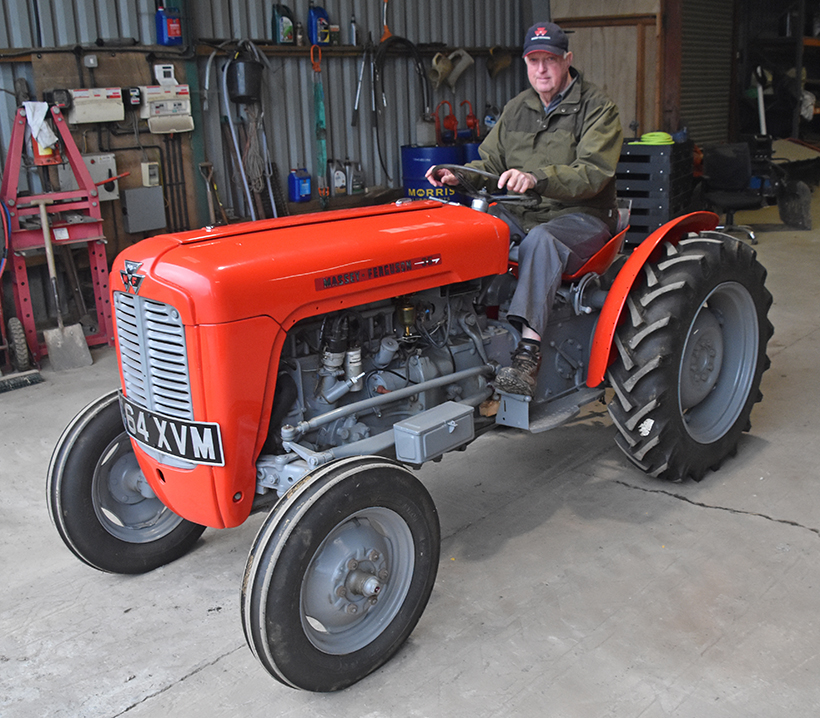
Edward Green has Massey red flowing through his veins!
As I was leaving the farm, I asked Edward to sum up his passion for Massey Ferguson. “I’ve never really liked any other makes of tractor and it’s always been Massey Ferguson for me,” he said. “As the saying goes, if I cut my finger, I bleed red.’ A sentiment that’s shared by countless other Red Giant enthusiasts, I’m sure!
Ferguson trailer development
Harry Ferguson is believed to have said: “A tractor without an implement is like a pen without ink.” This statement put farming mechanisation into context. Ferguson built his tractors with an implement in mind, in the process taking efficient farming to new levels.
Never an inventor known for doing things by halves, Ferguson designed an implement for most labour-intensive jobs on the farm. Trailers were a particular favourite, more often than not towed behind a Ferguson TE-20.
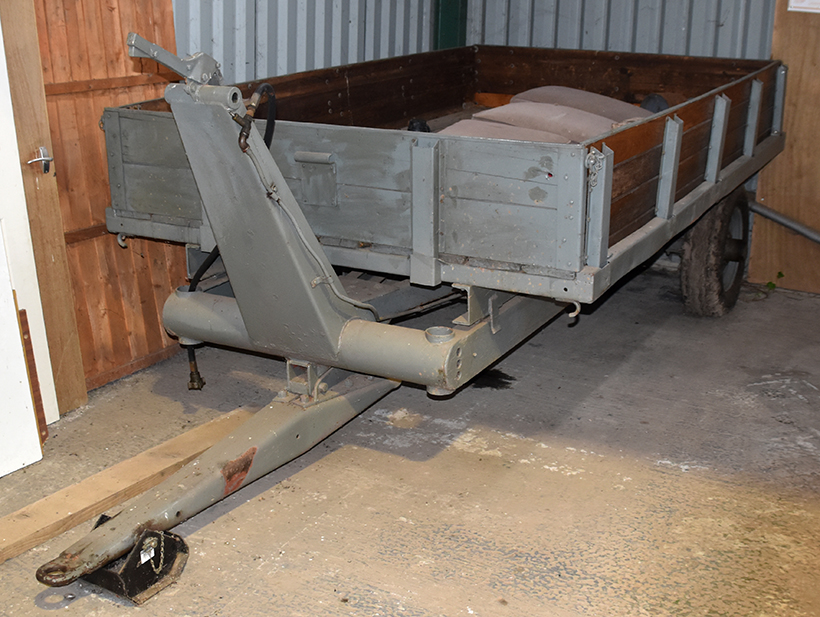
The grey Massey Ferguson Mk 1 is an increasingly rare trailer these days. The model was produced until mid-1947.
Ferguson had become known for his concept of implement weight transfer, so it was natural for him to apply the same principles to designing trailers. The trailers relied on the pick-up hitch for efficiency, and the load was carried below the rear axle. This was in marked contrast to most of the competition.
The pick-up hitch was key to the arrangement. Prior to this, his ‘Mark I’ trailer had been designed with two separate connections to the tractor; one to carry the weight and the other to apply the pulling force. One of the key components was the telescopic weight-carrying attachment. Connected to the ‘long pin’ just below the draft control spring, this was angled so that the load was transferred to a point between the front and rear axles.
Among other benefits, this reduced the tendency for the tractor to rear up, with potentially dire consequences for the driver. A yoke was located at its lower end, which allowed for articulation when cornering. A solid bar was attached between the yoke and the nine-hole drawbar, which held the bottom of the telescopic arrangement at a convenient angle for coupling the trailer to the tractor. It also stopped the arms from reaching the top of their travel and activating the pressure release – an essential arrangement to allow the trailer to tip.

Massey implements are the name of the game, as far as Edward’s concerned.
The trailer was towed by two rods, attached to the back axle via an articulated crossbar. Because it lacked a conventional drawbar, there was nowhere to put a jack stand. This meant that two, retractable legs had to carry the trailer when un-hooked. Of course, the introduction of the pick-up hitch in 1947 made the Mark I trailer obsolete overnight, and many were converted to include a towing eye, either by a blacksmith or Ferguson dealers.
This feature comes from the latest issue of Classic Massey & Ferguson Enthusiast, and you can get a money-saving subscription to this magazine simply by clicking HERE
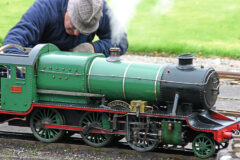
Previous Post
Strathaven Miniature Railway’s 75th birthday celebrations

Next Post
Visiting the excellent National Emergency Services Museum



